Energy Storage System Market Research, 2032
The global energy storage system market was valued at $198.8 billion in 2022, and is projected to reach $329.1 billion by 2032, growing at a CAGR of 5.2% from 2023 to 2032. Renewable energy integration has become increasingly important due to environmental concerns and technological advancements. However, the intermittent of renewable energy sources like wind and solar makes it challenging to integrate them into the grid. However, energy storage systems help by storing excess energy during peak production times and releasing it when demand is high or renewable generation is low. This ensures a reliable and stable energy supply while maximizing the utilization of clean, sustainable energy sources.
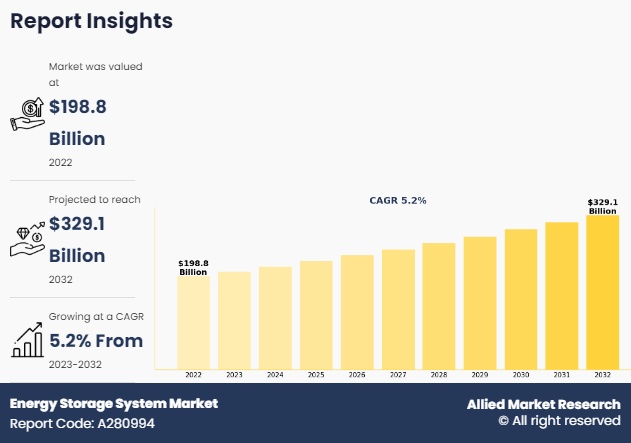
The global Energy Storage System Market is growing due to several factors such as renewable energy integration, regulatory support and incentives, trends toward decentralization, and the development of microgrids. However, lack of standardization and perception of risk restrains the development of the market. In addition, the surge in electric vehicle charging infrastructure and ongoing rural electrification initiatives in developing countries will provide ample opportunities for the market's development during the forecast period.
Key Takeaways
- The global energy storage system market is highly fragmented, with several players including Scheider Electric, SMA Solar Technology AG, Exide Industries Ltd., SK Holdings, Autobat, Enerbrax Acumuladores Ltda, Eguana Technologies, Imergy Power Systems, Ionotec Ltd, and Tata Power.
- More than 6,765 product literatures, industry releases, annual reports, and other such documents of major energy storage system industry participants along with authentic industry journals, trade associations' releases, and government websites have been reviewed for generating high-value industry insights.
- The study covers more than 20 countries across the globe in terms of value during the forecast period 2022-2032 is covered in the energy storage system market report.
Introduction
Energy storage systems (ESS) play a vital role in modern energy management, particularly in energy integration, grid stabilization, and the transportation sector. It is a crucial technology for capturing, storing, and releasing energy for later use. Key components of an energy storage system include energy storage medium which includes batteries, pumped hydro storage, compressed air energy storage, and flywheel energy storage.
Energy storage systems are required to follow three steps such as energy input, energy management system (EMS), and energy output. Most of the energy input is mostly done from renewable energy sources, while EMS controls the charging and discharging of ESS to ensure efficient operation and optimize energy flow.
Energy output is the process of releasing stored energy to power homes, businesses, industrial processes, and stabilizing the grid during high demand or fluctuations in renewable energy generation. Furthermore, ESS offers several advantages which include load balancing, renewable energy integration, grid stability, backup power, and peak shaving.
Market Dynamics
The lack of standardization in the energy storage system market presents a significant challenge for the widespread adoption and integration of energy storage devices. Without standardized protocols and interoperability standards, different energy storage technologies have compatibility issues, making it difficult to integrate them seamlessly into existing grid infrastructure or renewable energy systems. This lack of standardization also hampers scalability and limits the ability to achieve economies of scale, as each deployment may require customized solutions and unique engineering considerations. In addition, without clear industry standards, stakeholders face uncertainty regarding performance metrics, safety standards, and regulatory compliance, leading to hesitancy in investment and deployment.
The rapid expansion of electric vehicle (EV) adoption worldwide presents a significant opportunity for the energy storage system market. With the increasing demand for EV charging infrastructure, energy storage systems play a crucial role in supporting the development of fast-charging stations and managing the impact of EV charging on the grid. By integrating energy storage solutions into EV charging networks, it becomes possible to alleviate strain on the grid during peak charging times and ensure reliable and efficient charging services. In addition, energy storage systems enable the deployment of smart charging technologies, optimizing the utilization of renewable energy sources and reducing overall electricity costs for EV owners. The growth of the electric vehicle charging infrastructure industry represents a promising expansion of the market, offering opportunities for grid stabilization, demand management, and sustainable transportation solutions.
Segments Overview
The energy storage system market is segmented into technology, end-use, application, and region. On the basis of technology, the market is divided into pumped hydro storage, battery energy storage, compressed air energy storage, flywheel energy storage, and others. As per end-use, the market is segregated into residential, commercial, and industrial. On the basis of application, the market is bifurcated into stationary and transportation. Region wise, the market is analyzed across North America, Europe, Asia-Pacific, and LAMEA.
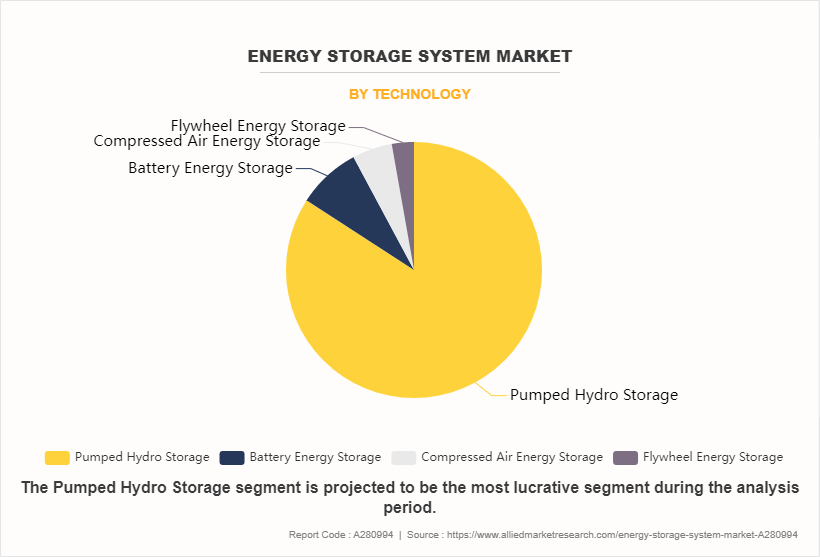
Based on technology, the pumped hydro storage segment held the highest market share in 2022, accounting for more than four-fifths of energy storage system market size. It is estimated to maintain its leadership status throughout the forecast period The combination of reliability, efficiency, scalability, and cost-effectiveness has positioned pumped hydro storage as a dominant technology in the market, particularly for grid-scale applications where long-duration storage and grid support services are critical.
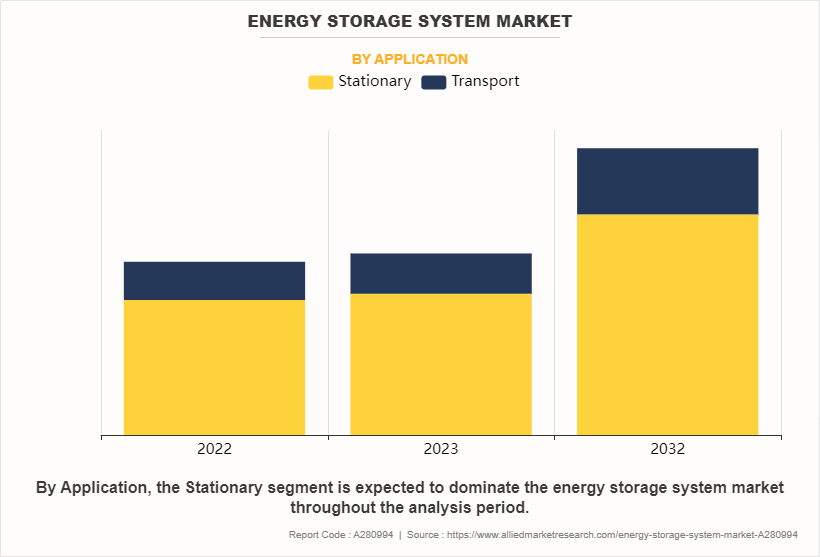
Based on the application, the stationary segment held the highest market share in 2022, accounting for nearly four-fifths of the energy storage system market share, and is estimated to dominate during the forecast period. Stationary energy storage systems command a significant market share due to their versatility, reliability, and broad applicability across various sectors. These systems offer a scalable solution for storing excess renewable energy, optimizing grid performance, and providing backup power during outages. With advancements in technology, such as lithium-ion batteries, stationary energy storage systems have become increasingly cost-effective and efficient, making them attractive for utilities, commercial enterprises, and residential consumers.
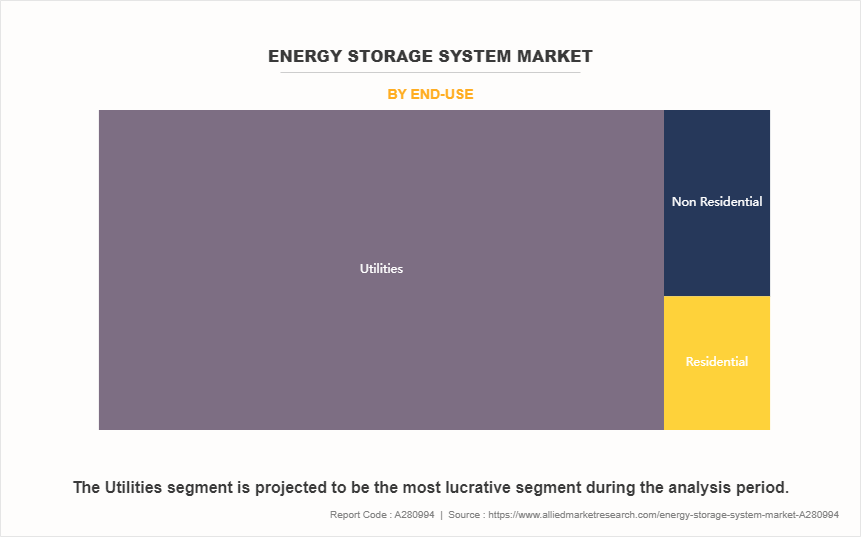
Based on the end-use, the utilities segment held the highest market share in 2022, accounting for more than four-fifths of the energy storage system market revenue, and is estimated to dominate during the forecast period. The high demand for energy storage systems in utilities' end-use arises from the imperative to optimize grid operations, manage peak demand efficiently, integrate increasing levels of renewable energy sources, and enhance grid resilience. Utilities rely on energy storage to mitigate intermittency issues associated with renewables, ensuring a stable and reliable power supply.
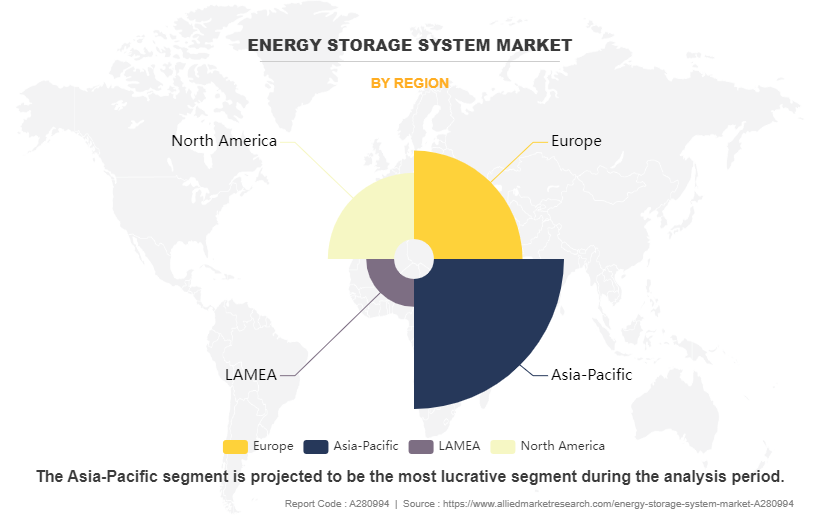
Based on the region, Asia-Pacific held the highest market share in 2022, accounting for more than two-fifths of the market revenue, and is estimated to dominate during the energy storage system market forecast. However, the Asia-Pacific segment is projected to manifest the highest CAGR of 5.7% from 2023 to 2032. The combination of growing energy demand, renewable energy deployment, supportive government policies, technological advancements, and a thriving supply chain is fueling the energy storage system market growth in the Asia-Pacific region.
In the U.S., more than 90% of the energy storage is done through pumped hydro storage. Whereas the other 10% comprises storage technologies such as battery, compressed air, and flywheel energy. Pumped hydroelectric pumps water up to a reservoir, which is then released through a turbine to generate electricity. Compressed air is compressed at up to 1,000 pounds per square inch and stored in underground caverns. Flywheels conserve energy as kinetic rotational energy, which is then used to turn a generator when needed. Large batteries, using technologies like lithium ion, lead acid, or lithium iron, can store electricity until it is needed. Thermal energy storage involves producing thermal energy, which can be stored until needed, such as producing chilled water or ice during low demand and cooling during peak electricity consumption.
Competitive Analysis
The major players operating in the energy storage system market include Scheider Electric, SMA Solar Technology AG, Exide Industries Ltd., SK Holdings, Autobat, Enerbrax Acumuladores Ltda, Eguana Technologies, Imergy Power Systems, Ionotec Ltd, and Tata Power.
Recent Developments in Energy Storage System Industry
- In March 2024, Schneider Electric and Hy Stor Energy have signed a memorandum of understanding to support the development of Hy Stor Energy's Mississippi Clean Hydrogen Hub (MCHH) and its U.S. development platform. The partnership aims to address large-scale energy and sustainability challenges, transitioning to renewable and fossil-free energy systems. Schneider Electric will provide automation, safety solutions, AI optimization software, weather analysis, predictive operations, and digital energy management tools.
- In November 2023, Schneider Electric invested $1.7M in a cutting-edge battery lab in Bengaluru (Bangalore) which will be equipped with cutting-edge tools, modern safety systems, and dedicated testing chambers. The facility ensures optimal battery performance while adhering to rigorous safety.
Key Benefits for Stakeholders
- This report provides a quantitative analysis of the market segments, current trends, estimations, and dynamics of the energy storage system market analysis from 2022 to 2032 to identify the prevailing energy storage system market opportunities.
- The market research is offered along with information related to key drivers, restraints, and opportunities.
- Porter's five forces analysis highlights the potency of buyers and suppliers to enable stakeholders make profit-oriented business decisions and strengthen their supplier-buyer network.
- In-depth analysis of the energy storage system market segmentation assists to determine the prevailing market opportunities.
- Major countries in each region are mapped according to their revenue contribution to the global energy storage system market statistics.
- Market player positioning facilitates benchmarking and provides a clear understanding of the present position of the market players.
- The report includes the analysis of the regional as well as global energy storage system market trends, key players, market segments, application areas, and market growth strategies.
Energy Storage System Market Report Highlights
| Aspects | Details |
| Market Size By 2032 | USD 329.1 billion |
| Growth Rate | CAGR of 5.2% |
| Forecast period | 2022 - 2032 |
| Report Pages | 250 |
| By Technology |
|
| By Application |
|
| By End-Use |
|
| By Region |
|
| Key Market Players | SK Holdings, Ionotec Ltd, Tata Power Company Ltd, Enerbrax, Imergy Power Systems, Autobat SACI, EXIDE INDUSTRIES LTD., Schneider Electric, SMA Solar Technology AG, Eguana Technologies |
Analyst Review
According to the opinions of various CXOs of leading companies, the energy storage system market was dominated by the pumped hydro storage technology segment in 2022.
The surge in renewable energy integration and grid modernization initiatives has contributed to the growth of the energy storage systems market, with a particular emphasis on segments such as lithium-ion batteries and grid-scale storage solutions. As major countries globally invest in renewable energy projects and transition towards a cleaner energy landscape, the demand for energy storage systems is expected to escalate further.
The expansion of renewable energy sources, coupled with advancements in grid infrastructure, has propelled the need for energy storage systems to ensure grid stability and reliability. The surge in transportation infrastructure projects, including electric vehicle charging infrastructure, also presents opportunities for energy storage system providers. As the demand for electric vehicles grows and the need for reliable charging infrastructure intensifies, energy storage systems play a pivotal role in supporting fast-charging stations and managing peak demand.
CXOs are prioritizing innovation in energy storage solutions, focusing on scalability, efficiency, and sustainability to meet the evolving needs of the market while addressing environmental challenges. Moreover, investments in smart technologies like IoT and data-driven insights are enabling energy storage system providers to optimize performance and enhance grid integration, thereby driving market growth and differentiation in a competitive landscape.
The global energy storage system market is expected to grow at a CAGR of 5.2% from 2023 to 2032, reaching a value of $329.1 billion by 2032..
Upcoming trends in the global energy storage system market include declining costs, increased integration of renewable energy, grid modernization, electrification of transportation, and the growth of decentralization and microgrids.
Stationary is the leading application of Energy Storage System Market in 2023.
Asia-Pacific is the largest regional market for Energy Storage System during the forecast period.
Scheider Electric, SMA Solar Technology AG, Exide Industries Ltd., SK Holdings, Autobat, Enerbrax Acumuladores Ltda, Eguana Technologies, Imergy Power Systems, Ionotec Ltd, and Tata Power are the top companies to hold the market share in Energy Storage System.
Loading Table Of Content...
Loading Research Methodology...



